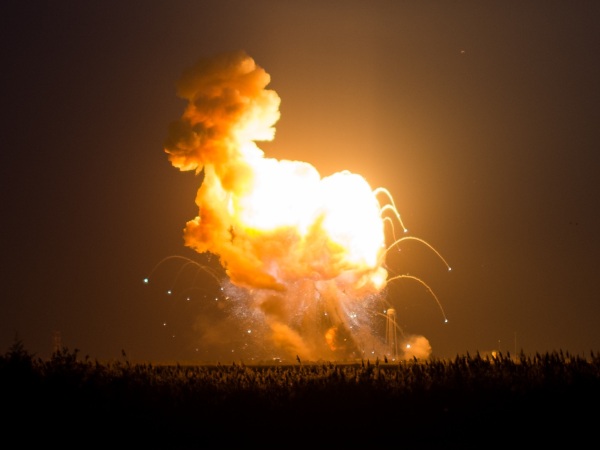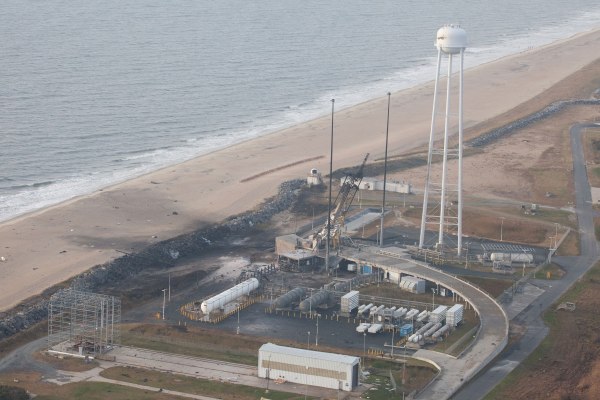
This past Tuesday, October 28, at 6:22 p.m. EDT, an Orbital Sciences Antares rocket lifted off from the shorefront pad at NASA’s Wallops Space Flight Facility in Virginia, the Cygnus vehicle inside its fairing . The third of eight planned launches in Orbital Sciences’ $1.9-billion NASA contract, the Orb-3 mission was to deliver over 5,000 lbs of cargo to the International Space Station after a beautiful nighttime launch that would be visible to viewers up and down the U.S. East Coast.
Except, as you probably know by now, that’s not at all what happened.
Just six seconds after ignition and liftoff from the pad, a series of explosions ran through the Antares rocket. Ablaze, the 133-foot-tall stack stopped in midair and then fell back onto the pad in a fiery smear, where it and its contents of fuels and cargo detonated in an enormous explosion. It was incredible, it was catastrophic, it was awful.
Over five and a half tons of supplies, equipment and experiments destined for the Space Station — some of which represented years of work for researchers of all ages around the world — were instantly obliterated in a few seconds of explosive fury. And many of us were watching live.
Watch the NASA TV video stream footage of the launch and explosion below:
“I knew as a scientist and journalist that I was watching a mounting disaster unfolding before my eyes,” wrote fellow Universe Today journalist Ken Kremer, who was watching the launch on-site. Read his firsthand account and see some of his photos here.
And if you want to see something really wild, here’s footage of the explosion caught on camera from a plane at 3,000 feet.
One saving grace of the whole event is that the mission was uncrewed and nobody was hurt by the explosion. All damage was to the rocket, capsule and contents, and the pad structure. (And, unfortunately, to the local shoreline environment as well — apart from the fire and smoke the solid fuel inside the second stage and hydrazine within the Cygnus vehicle are not what you’d call eco-friendly.)

Orbital Sciences is conducting a full investigation of the mishap in an attempt to determine the cause. Wallops Space Flight Facility will be busy with cleanup and repair of Pad 0A, and urges the public to avoid the cordoned-off areas and not to touch any debris that might be found. Read more about NASA’s investigation here.
If you think you’ve found rocket or cargo debris, please call Wallops’ Incident Response Team at 757-824-1295.
According to the NASA release “it will take many more weeks to further understand and analyze the full extent of the effects of the event.”
See the full press conference held the evening of the event below:
I can’t help but suspect that the cause of the Orb-3 Antares explosion is related to the “significant failure” experienced during a test of the same type of Russian-built Aerojet Rocketdyne AJ26 engine used in the Antares first stage, back in May 2014 at Stennis Space Center. (Read more about that here, also from Ken Kremer.) This was Orbital Sciences’ third explosive launch failure.
Although the Cygnus vehicle was carrying supplies for astronauts and cosmonauts aboard the ISS, none of those were considered crucial and the crew members will be fine without this shipment. According to NASA’s Bill Gerstenmaier during the press conference, “there was no cargo that was absolutely critical to us…we’re all set on Station.”
But Gerstenmaier also reminded us that events like this cannot put a halt to our activities and progress in space.
“The thing that’s important is that we don’t overreact to this failure… We’ll learn from this event.”
Just another reminder that space travel is, in fact, still hard.
It is sad but, fortunately that this flight not including a crew…
Now it is necessary us to learn of this incident to avoid that it reproduces…
Jeff Barani from Vence (France)
LikeLike
And even more sad, the crash of the spaceship Virgin Galactic : a broken spatial dream ;-(
Jeff Barani from Vence (France)
LikeLike